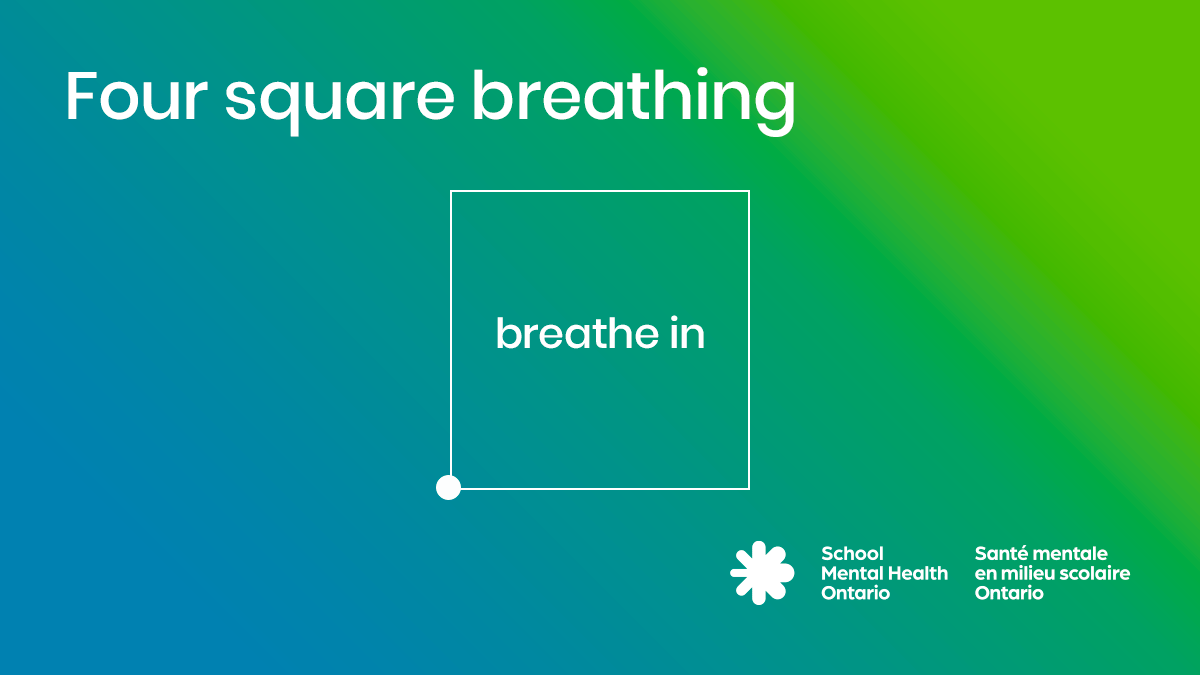


Time
10-15 minutes
Level
Primary / Junior / Intermediate
Material
Music (optional)
Purpose
To help students develop a mind/body connection, self-regulation, awareness of emotions, and resiliency by practising deep breathing
Select a breathing practice that appeals to your group of students and your comfort level. For each practice, stand/sit with your back straight and keep your shoulders and head relaxed as you gaze forward.
| Deep belly breathing |
|
| Hot chocolate |
|
| Breathing kindness |
|

Four square breathing:
- breathe in
- hold
- breathe out
- hold
- Encourage students to inhale and think of God’s love for them, and when they exhale, think about the people around them that they will share that love with.
- Try this with students lying on their backs. Younger students may find it helpful to put an object on their stomach to watch it go up and down as they take a deep breath. Coach them on the breathing by counting in for four and then exhaling for four.
Guided breathing exercises are an effective tool to help students regulate emotions (Metz et al., 2013). These interventions decrease physiological arousal, so the emotion and anxiety students feel becomes less intense (Gregoski, Barnes, Tingen, Harshfield, & Treiber, 2011), and students can refocus their attention on learning.
Gregoski, M. J., Barnes, V. A., Tingen, M. S., Harshfield, G. A., & Treiber, F. A. (2011). Breathing Awareness Meditation and LifeSkills Training Programs Influence Upon Ambulatory Blood Pressure and Sodium Excretion Among African American Adolescents. Journal of Adolescent Health, 48(1), 59-64. doi:10.1016/j.jadohealth.2010.05.019
Metz, S. M., Frank, J. L., Reibel, D., Cantrell, T., Sanders, R., & Broderick, P. C. (2013). The Effectiveness of the Learning to BREATHE Program on Adolescent Emotion Regulation. Research in Human Development, 10(3), 252-272. doi:10.1080/15427609.2013.818488
‘Then the LORD God formed man of dust from the ground and breathed into his nostrils the breath of life; and man became a living being.’ (Genesis 2:7)
On the day that God created us, He took a deep breath in and inhaled all His love, joy, happiness, peace, kindness, forgiveness, gratitude and then He exhaled and breathed into us all His love, peace, kindness, forgiveness, and gratitude for ourselves and to be shared with others. Taking time to focus on breath can help students prepare their body and mind reflection and prayer.
(3a) A reflective, creative and holistic thinker who recognizes there is more grace in our world than sin and that hope is essential in facing all challenges.
Self-regulation and well-being: to regulate emotions, adapt to distractions, and assess consequences of actions in a way that enables engagement in learning
I take a few breaths, like you guys taught us to do, and sometimes I meditate, so I just calm myself.
Or, view all practices and use filters to find what you need
